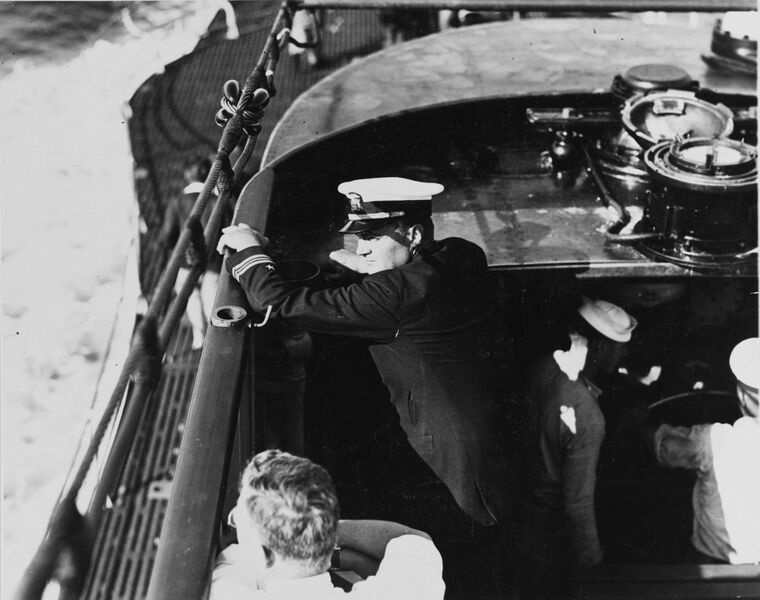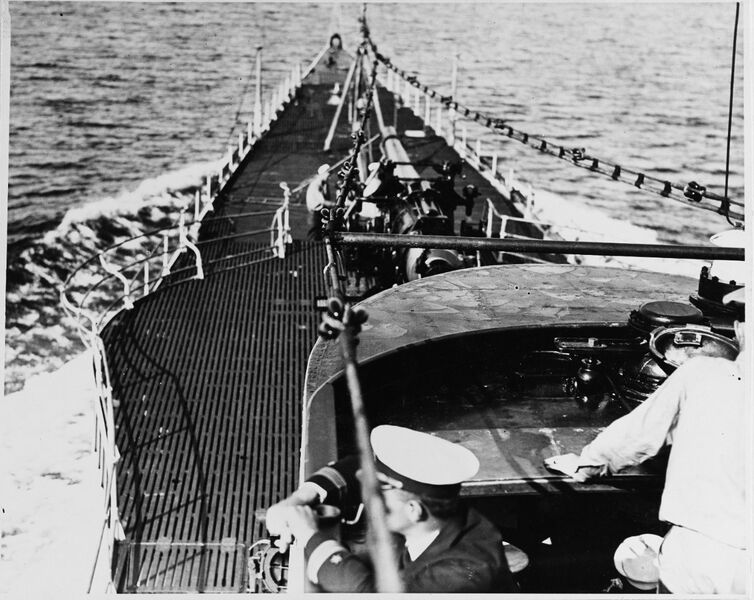167: Difference between revisions
Pbcjohnston (talk | contribs) mNo edit summary |
Pbcjohnston (talk | contribs) (Moved photos) |
||
| (One intermediate revision by the same user not shown) | |||
| Line 35: | Line 35: | ||
<small>U.S. Navy photo</small> | <small>U.S. Navy photo</small> | ||
[[File:Red bar sub new 2.jpg]] | |||
[[File:V-5 at speed on trials NH 45650.jpg|left|500px]] | |||
V-5 running speed trials on the measured mile range off Provincetown, Cape Cod, Massachusetts on July 7, 1930. The Navy had long had a speed range in the sheltered waters of Cape Cod Bay and this was a common operating area for newly completed boats. The calm waters enabled the precise measurement of the boat's speed as it ran between two buoys that had been precisely placed. This photo shows her running at 11 knots, six knots below her rated maximum. During these runs, a lot of data was recorded on engine and drive train performance to ensure the boat could meet the specifications laid down for her by the Bureau of Construction & Repair. | |||
<small>Photo NH 45650 courtesy of NHHC.</small> | |||
[[File:Red bar sub new 2.jpg]] | [[File:Red bar sub new 2.jpg]] | ||
[[File:Narwhal sea trials -1.jpg|left|500px]] | [[File:Narwhal sea trials -1.jpg|left|500px]] | ||
<div style="text-align: justify;"><span style="color:#00008B">V-5 is photographed during builder's trials | <div style="text-align: justify;"><span style="color:#00008B">V-5 is photographed during builder's trials in the Atlantic in the fall of 1930. Upon commissioning on May 15, 1930 only the most rudimentary trials had been undertaken. Builder's trials continued for months after commissioning including a three month trip to the Caribbean. | ||
To get a feeling for the scale of the submarine, just above the "V", on the bridge, are two crewmembers and another to the right next the edge of the bridge. The submarine was the largest in the world at that time at 371 feet long with a 33 foot beam. | To get a feeling for the scale of the submarine, just above the "V", on the bridge, are two crewmembers and another to the right next the edge of the bridge. The submarine was the largest in the world at that time at 371 feet long with a 33 foot beam. | ||
Before the trials began V-5 traveled to Boston to take on supplies and | Before the trials began V-5 traveled to Boston to take on supplies and ordnance, ie; projectiles and their powder cartridges for her 6"/53 caliber guns and 24 torpedoes, split between the forward and after torpedo rooms. These tubes could take the [https://pigboats.com/index.php?title=Torpedo_photos_%26_information#BuOrd_Mark_14 '''newly developed MK 14 torpedo'''] which was 20 feet 6 inches long and 21 inches diameter. The previous 21-inch torpedo was the MK 10 Mod 3 at 16 feet 7 inches long. | ||
Some torpedoes were most likely practice "fish" with dummy warheads filled with water. During her torpedo trails one of these practice torpedoes made a circular run and punched a hole in her superstructure. The newspapers called the torpedo "fickle" making it sound less dangerous than it was. This was a harbinger of bad things to come. In reality the Mk 14 had been rushed into service and inadequately tested. It was full of bugs that would only come out once the weapons were fired en masse during WWII. | Some torpedoes were most likely practice "fish" with dummy warheads filled with water. During her torpedo trails one of these practice torpedoes made a circular run and punched a hole in her superstructure. The newspapers called the torpedo "fickle" making it sound less dangerous than it was. This was a harbinger of bad things to come. In reality the Mk 14 had been rushed into service and inadequately tested. It was full of bugs that would only come out once the weapons were fired en masse during WWII. | ||
| Line 51: | Line 58: | ||
The sub boasted some new features such as each crew member had two Momsen Lungs available to him. There were three escape trunks. The sub was large enough to have three galleys, one for enlisted crew, one for Warrant and Chief Petty Officers, and one for the Officers. | The sub boasted some new features such as each crew member had two Momsen Lungs available to him. There were three escape trunks. The sub was large enough to have three galleys, one for enlisted crew, one for Warrant and Chief Petty Officers, and one for the Officers. | ||
All 80 crew plus officers had a bunk to themselves. The crew was also provided with movies, and | All 80 crew plus officers had a bunk to themselves. The crew was also provided with movies, and she was equipped for the new talking movies since there was the space for their stowage. | ||
The submarine also boasted of having eight showers and steam and electric heating. Electric motors were to be powering all equipment and the steering and diving operations. There is no mention of there being any hydraulics on the submarine. | The submarine also boasted of having eight showers and steam and electric heating. Electric motors were to be powering all equipment and the steering and diving operations. There is no mention of there being any hydraulics on the submarine. | ||
| Line 64: | Line 71: | ||
[[File:Narwhal sea trials-2.jpg|left|500px]] | [[File:Narwhal sea trials-2.jpg|left|500px]] | ||
<div style="text-align: justify;"><span style="color:#00008B">This is a nice two photo progression sequence of the submarine V-5 diving. She is on builder's trials | <div style="text-align: justify;"><span style="color:#00008B">This is a nice two photo progression sequence of the submarine V-5 diving. She is on builder's trials in the Atlantic Ocean. Her last diving trials were performed between October 29 and October 31, 1930 off Provincetown as reported in the local newspapers. | ||
<small>Photo in the private collection of Ric Hedman</small> | <small>Photo in the private collection of Ric Hedman</small> | ||
Revision as of 10:34, 14 October 2024
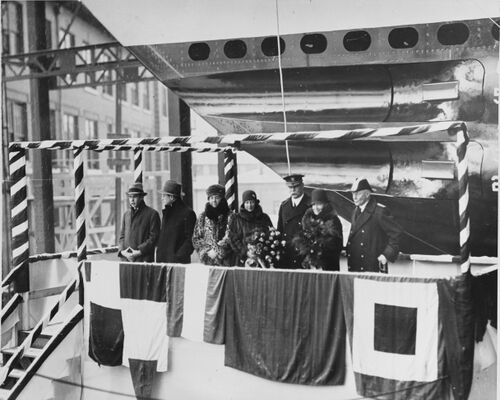
The outer doors and hydrodynamic shutters for the port side bow torpedo tubes can be seen above the party, along with some free flooding limber holes.
U.S. Navy photo NH 45648 via NHHC.
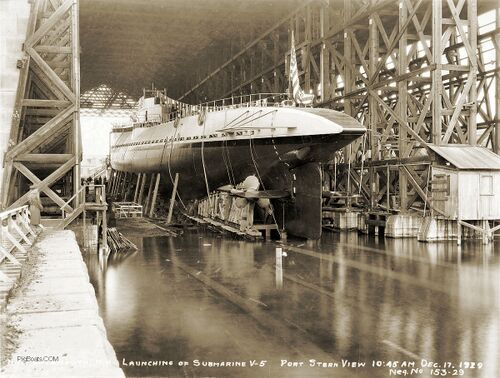
V-5 is seen here just prior to launch on December 17, 1929 at the Portsmouth Navy Yard in Kittery, ME. The submarine is dressed with flags and bunting. It was a cold snowy day. The white on the left foreground is snow. The smooth shiny surface is actually water. The tracks of the skid-way can be seen beneath the surface. V-5's aft torpedo tubes can be seen under the tip of the stern.
U.S. Navy photo
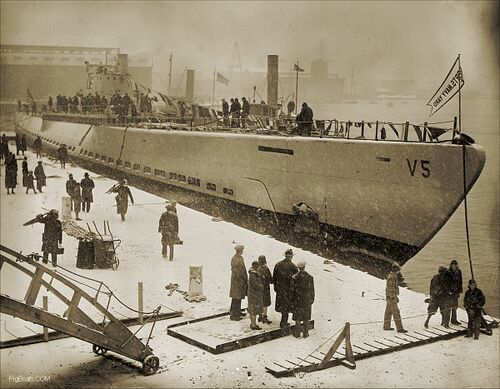
U.S. Navy photo
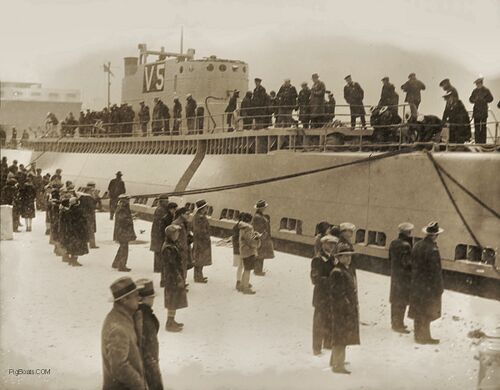
U.S. Navy photo
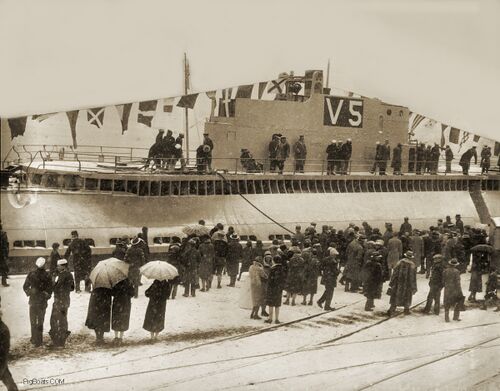
U.S. Navy photo

V-5 running speed trials on the measured mile range off Provincetown, Cape Cod, Massachusetts on July 7, 1930. The Navy had long had a speed range in the sheltered waters of Cape Cod Bay and this was a common operating area for newly completed boats. The calm waters enabled the precise measurement of the boat's speed as it ran between two buoys that had been precisely placed. This photo shows her running at 11 knots, six knots below her rated maximum. During these runs, a lot of data was recorded on engine and drive train performance to ensure the boat could meet the specifications laid down for her by the Bureau of Construction & Repair.
Photo NH 45650 courtesy of NHHC.
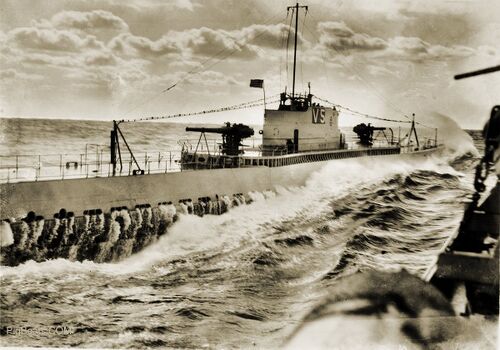
To get a feeling for the scale of the submarine, just above the "V", on the bridge, are two crewmembers and another to the right next the edge of the bridge. The submarine was the largest in the world at that time at 371 feet long with a 33 foot beam.
Before the trials began V-5 traveled to Boston to take on supplies and ordnance, ie; projectiles and their powder cartridges for her 6"/53 caliber guns and 24 torpedoes, split between the forward and after torpedo rooms. These tubes could take the newly developed MK 14 torpedo which was 20 feet 6 inches long and 21 inches diameter. The previous 21-inch torpedo was the MK 10 Mod 3 at 16 feet 7 inches long.
Some torpedoes were most likely practice "fish" with dummy warheads filled with water. During her torpedo trails one of these practice torpedoes made a circular run and punched a hole in her superstructure. The newspapers called the torpedo "fickle" making it sound less dangerous than it was. This was a harbinger of bad things to come. In reality the Mk 14 had been rushed into service and inadequately tested. It was full of bugs that would only come out once the weapons were fired en masse during WWII.
Food was loaded for 3 months. She also had the latest in mechanical refrigeration allowing more perishable foods to be carried for longer times. She carried fuel to travel 15,000 miles.
The sub boasted some new features such as each crew member had two Momsen Lungs available to him. There were three escape trunks. The sub was large enough to have three galleys, one for enlisted crew, one for Warrant and Chief Petty Officers, and one for the Officers.
All 80 crew plus officers had a bunk to themselves. The crew was also provided with movies, and she was equipped for the new talking movies since there was the space for their stowage.
The submarine also boasted of having eight showers and steam and electric heating. Electric motors were to be powering all equipment and the steering and diving operations. There is no mention of there being any hydraulics on the submarine.
She also conducted a deep driving trial and established what she thought must be an American record for a depth at 332 feet resting on the bottom of the Atlantic off Boone Island, Maine. Once on the bottom the sub remained there for about 45 minutes running tests on all the equipment and pumps.
She did experience a small leak in her after torpedo room on her ascent which the crew simply placed a bucket under to be taken care of later. Riveted hulls weeped and small leaks were common. The sub made several stops at 200 and 150 feet before surfacing.
Photo in the private collection of Ric Hedman
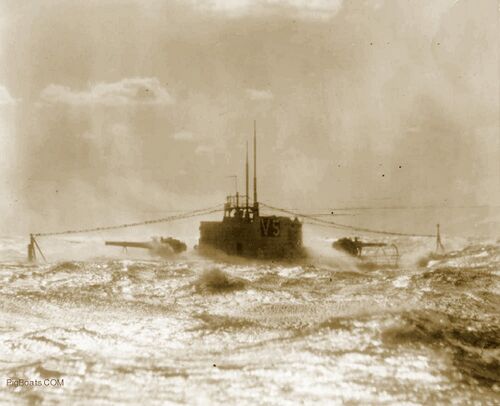
Photo in the private collection of Ric Hedman

Original AP Wire photo in the private collection of Ric Hedman

U.S. Navy photo
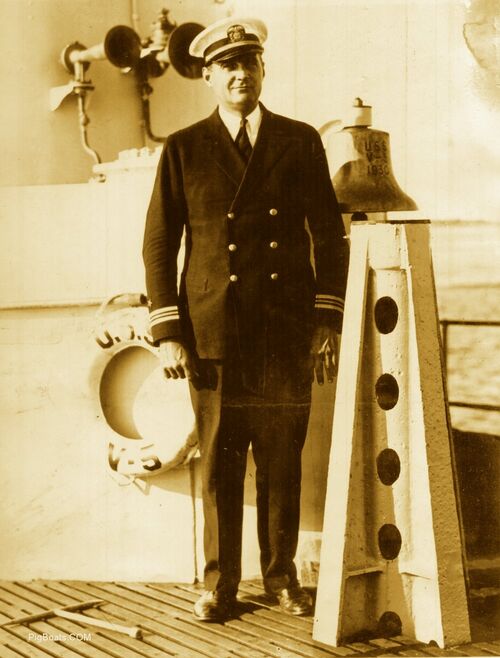
One of the most capable and highly regarded officers in the force, Brown had previously been the Commanding Officer of submarines C-2 (Submarine No. 13) and G-4 (Submarine No. 27) in World War I, then N-5 (SS-57) and R-2 (SS-79) between 1919 and 1921. He commanded the S-42 (SS-153) from 1924 to 1927 before assuming command of the V-5 in May 1930 until May of 1933.
Brown graduated from the Naval War College in 1940. He then became the Commanding Officer of the light cruiser Richmond (CL-9) 1941-1942. He then assumed command of Submarine Squadron Four in June 1942 until November 1943, serving under Rear Admiral Charles Lockwood in Pearl Harbor. He was promoted to Rear Admiral in January 1943. He was Commander Submarine Training Command from 1943 to 1945 where he was instrumental in creating the Submarine Lifeguard League that rescued pilots that were shot down in combat during WW II. He became a Vice Admiral upon retirement in February 1954.
His decorations include the Navy Distinguished Service Medal and two Legion of Merit awards.
Original AP Wire photo in the private collection of Ric Hedman
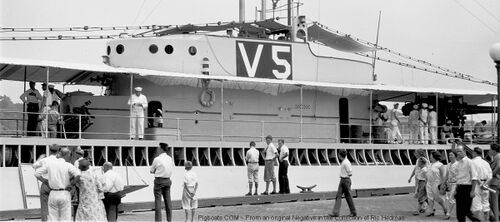
There are several interesting features in this close up of the conning tower fairwater. A large awning has been erected to shade the boat from the summer heat. At this point V-5 did not yet have an air-conditioning plant. On the forward end of the fairwater the Narwhal had a gun access trunk that allowed crew access directly to the main deck for the gun crews. Just below the trunk hatch is a powered ammunition hoist. The 6-inch shells for the guns and their separate powder bags where too heavy to pass up from the magazine by hand. The power hoist greatly eased this chore and speeded up gun firing times. There was another hoist by the aft end of the fairwater on the starboard side. Just to the left of the hoist a visitor is standing on the ship's accommodation ladder with his hands on the rails. The ladder penetrated the deck and came out of the side of the superstructure, the doors for which are partially obscured by the small crowd on the pier. One of the huge 6"/53 caliber Mk 17 guns is visible on the right in the picture.
Image from an original negative in the private collection of Ric Hedman

U.S. Navy photo NH 45651 courtesy of the NHHC.
U.S. Navy photos NH 50135 and NH 45644 via NHHC.

Photo in the private collection of Ric Hedman
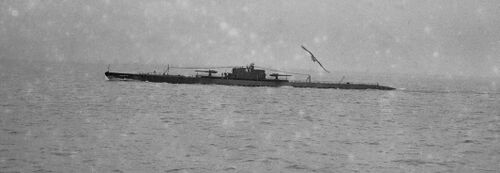
Narwhal underway on the surface in the Pacific, 1935-1939, with a seagull as an aerial escort. Operating out of San Diego, Narwhal ranged the U.S. Pacific coastline in these years, making voyages as far north as Seattle and west to Hawaii. She would shift her homeport out to Hawaii in 1941 and was present in Pearl Harbor on December 7, 1941.
Photo courtesy of the UCLA Digital Liobrary.
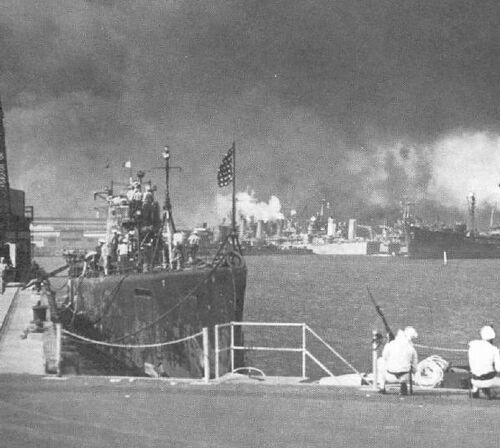
U.S. Navy photo
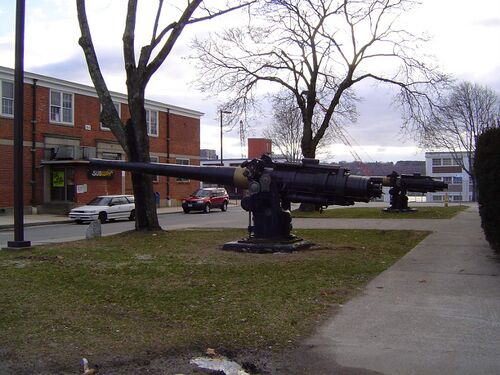
Original photo by David Johnston
Page created by:
Ric Hedman & David Johnston
1999 - 2023 - PigBoats.COM©
Mountlake Terrace, WA, Norfolk, VA
webmaster at pigboats dot com

